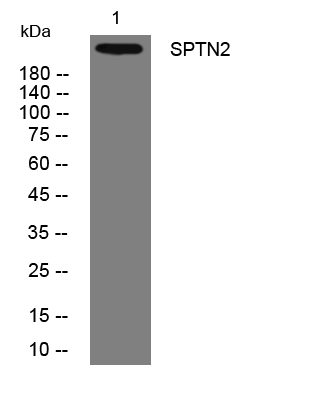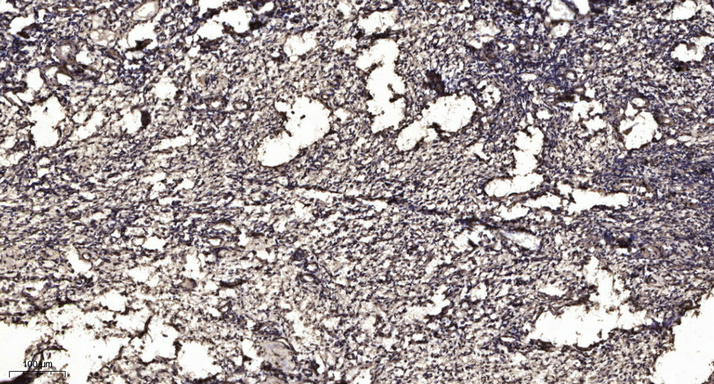SPTN2 rabbit pAb
- Catalog No.:YT7269
- Applications:WB;IHC
- Reactivity:Human;Rat
- Target:
- SPTN2
- Fields:
- >>Spinocerebellar ataxia;>>Pathways of neurodegeneration - multiple diseases
- Gene Name:
- SPTBN2 KIAA0302 SCA5
- Protein Name:
- SPTN2
- Human Gene Id:
- 6712
- Human Swiss Prot No:
- O15020
- Rat Gene Id:
- 29211
- Rat Swiss Prot No:
- Q9QWN8
- Immunogen:
- Synthesized peptide derived from human SPTN2 AA range: 644-694
- Specificity:
- This antibody detects endogenous levels of SPTN2 at Human/Rat
- Formulation:
- Liquid in PBS containing 50% glycerol, 0.5% BSA and 0.02% sodium azide.
- Source:
- Polyclonal, Rabbit,IgG
- Dilution:
- WB 1:500-2000;IHC 1:50-300
- Purification:
- The antibody was affinity-purified from rabbit antiserum by affinity-chromatography using epitope-specific immunogen.
- Concentration:
- 1 mg/ml
- Storage Stability:
- -15°C to -25°C/1 year(Do not lower than -25°C)
- Molecular Weight(Da):
- 263kD
- Background:
- Spectrins are principle components of a cell's membrane-cytoskeleton and are composed of two alpha and two beta spectrin subunits. The protein encoded by this gene (SPTBN2), is called spectrin beta non-erythrocytic 2 or beta-III spectrin. It is related to, but distinct from, the beta-II spectrin gene which is also known as spectrin beta non-erythrocytic 1 (SPTBN1). SPTBN2 regulates the glutamate signaling pathway by stabilizing the glutamate transporter EAAT4 at the surface of the plasma membrane. Mutations in this gene cause a form of spinocerebellar ataxia, SCA5, that is characterized by neurodegeneration, progressive locomotor incoordination, dysarthria, and uncoordinated eye movements. [provided by RefSeq, Dec 2009],
- Function:
- disease:Defects in SPTBN2 are the cause of spinocerebellar ataxia type 5 (SCA5) [MIM:600224]. Spinocerebellar ataxia is a clinically and genetically heterogeneous group of cerebellar disorders. Patients show progressive incoordination of gait and often poor coordination of hands, speech and eye movements, due to degeneration of the cerebellum with variable involvement of the brainstem and spinal cord. SCA5 is an autosomal dominant cerebellar ataxia (ADCA). It is a slowly progressive disorder with variable age at onset, ranging between 10 and 50 years.,function:Probably plays an important role in neuronal membrane skeleton.,similarity:Belongs to the spectrin family.,similarity:Contains 1 PH domain.,similarity:Contains 17 spectrin repeats.,similarity:Contains 2 CH (calponin-homology) domains.,tissue specificity:Highly expressed in brain, kidney, pancreas, and liver, and at lower levels in
- Subcellular Location:
- Cytoplasm, cytoskeleton. Cytoplasm, cell cortex.
- Expression:
- Highly expressed in brain, kidney, pancreas, and liver, and at lower levels in lung and placenta.
- June 19-2018
- WESTERN IMMUNOBLOTTING PROTOCOL
- June 19-2018
- IMMUNOHISTOCHEMISTRY-PARAFFIN PROTOCOL
- June 19-2018
- IMMUNOFLUORESCENCE PROTOCOL
- September 08-2020
- FLOW-CYTOMEYRT-PROTOCOL
- May 20-2022
- Cell-Based ELISA│解您多样本WB检测之困扰
- July 13-2018
- CELL-BASED-ELISA-PROTOCOL-FOR-ACETYL-PROTEIN
- July 13-2018
- CELL-BASED-ELISA-PROTOCOL-FOR-PHOSPHO-PROTEIN
- July 13-2018
- Antibody-FAQs
- Products Images

- Western blot analysis of lysates from K562 cells, primary antibody was diluted at 1:1000, 4°over night

- Immunohistochemical analysis of paraffin-embedded human oophoroma. 1, Antibody was diluted at 1:200(4° overnight). 2, Tris-EDTA,pH9.0 was used for antigen retrieval. 3,Secondary antibody was diluted at 1:200(room temperature, 45min).



